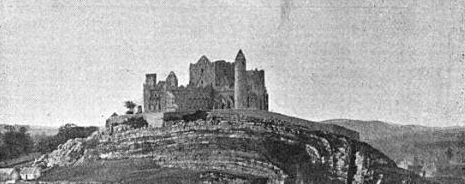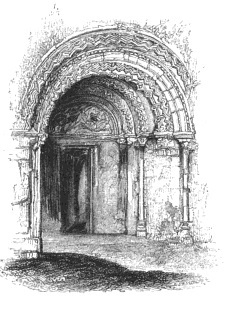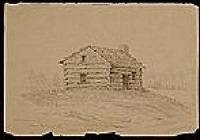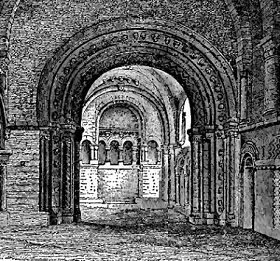Judy Malloy:
From Ireland with Letters Part VI:
Gone with Our Wanderers
"Giovanni Duprè," he said out loud.
Some Irish people summon poets
in that way
or so his father had once told him.
"In our family," his father had said ominously.
"O'Brien's."
They were sitting in the pub
that his mother's family ran.
Drinking free beer.
Liam looked around the cafe
to make sure that no one had heard him utter
the name of an Italian sculptor out loud.
"Giovanni Duprè"
Gone with Our Wanderers
Electronic Literature has come of age in many ways. For me it is
a continued focus on the distinction of screen-based story set in motion; the hunting, gathering and remixing of ancient and contemporary narrative; the thrill of inventing a way to score words like music; honing the craft of telling a story in the public square of the Internet; and the interactivity of allowing the reader the choice to click rather than wait for the word music to progress.
In Gone with Our Wanderers, a scholar confronts the known and the unknown in both his life and his work, as
with dense, rhythmic polyphonic text,
the narrative shifts from the
Junction of Several Trails meeting of Máire Powers and Liam O'Brien (backed
by a continuo
of Irish lyrics and the literature of the Gaelic Revival)
to intertwined identity explorations of the time and place of Irish American sculptor, Hiram Powers -- who creates an
iconic Abolitionist work in Florence against a background of The Risorgimento -- and Liam O'Brien, the Irish American Scholar who pursues his story.
Along the way, in a polyphonic 19th century remix, Gone with Our Wanderers replays the words of 19th century Florentine sculptor Giovanni Duprè; replays Giuseppe Verdi's words from his autobiography that concern his antislavery opera Nabucco; replays the Narrative of the Adventures and Escape of Moses Roper from American Slavery, which was published in London in 1837 and went through at least 11 editions. It is 1842. Hiram Powers is in his studio in Florence, creating a model for The Greek Slave. It is the year that Nabucco premiered at La Scala in Milan. The Irish woman poet Frances Browne has just published "Songs of Our Land" in the Irish Penny Journal. Her words echo in a 21st century art historian's informal translation of the chorus of Hebrew slaves from Nabucco: "Va Pensiero". It is 1844, Hiram Powers and the Italian sculptors who work with him are sitting beside the partially carved marble sculpture of The Greek Slave. It is the year that Nabucco was first performed in Florence.
I have for many years -- since I first told Uncle Roger on Art Com Electronic Network on The WELL in 1986 -- been working with the oral literature aspects of telling a story in the Homeric tradition, in an electronic community or "town square" of people seen and unseen on the World Wide Web. Gone with Our Wanderers is part VI of my continuing epic work of public literature: From Ireland with Letters -- told online, beginning in 2010.
fiddlers_passage
fiddlers_passage, the authoring system for Gone with Our Wanderers, uses the text-based musical composition system that I began in 1991 with
Wasting Time (After the Book, Perforations 3, Summer, 1992) and resumed in Berkeley in 2009. The fiddlers_passage scoring systems was begun in 2012 when Willi Apel's The Notation of Polyphonic Music 900-1600, fell open to page 316 in the chapter on Franconian Notation, and I encountered a facsimile from the circa 13th century Montpellier Manuscript: "huic ut": "in which the magi bring mystical gifts..."
either by watching the words play like a piece of music
or by clicking on the words to advance the narrative
Gone with Our Wanderers
is best read on a laptop screen with "view full screen" selected. The work should run on any platform and browser, but Explorer or Firefox are recommended. It can be read either by watching the words play like a piece of music or by clicking on the words to advance the narrative in a way that the reader choses. In the latter case, there will be times when the music is silent. Wait, and it will return. Once in a while, the the tracks do not all display; reloading the work usually fixes the problem.
Gone with Our Wanderers
is copyright 2013-2014 Judy Malloy. It is part VI of
From Ireland with Letters
More information about Gone with Our Wanderers is in the
Online writer's notebook for From Ireland with Letters Part VI

The Rock of Cashel, the Legendery seat of the O'Brien Clan
remixed from John Cooke,
Wakeman's Handbook of Irish Antiquities.
London: John Murray, 1903. 3rd ed. p. 313
Notation Resources
Willi Apel, The Notation of Polyphonic Music 900-1600, 4th edition, Cambridge, MA:
The Medieval Academy of America, 1949
In particular the chapter on Franconian Notation and the facsimile from the circa 13th century
Montpellier Manuscript ("huic ut" in which the magi bring mystical gifts...")
were influential in my shifting to measured notation in fiddlers
passage. Thus, Franconian notation was a turning point in music notation, and it was a also
a turning point in my work.
The Boulez-Cage Correspondence, edited by Jean-Jacques Nattiez, translated
and edited by Robert Samuels, Cambridge, UK: Cambridge University Press, 1993
Pierre Boulez, "Sonate, Que me Veux-tu", Perspectives of New Music
1:2, Spring 1963. p. 32-44
Nikolaus Harnoncourt, Baroque Music Today: Music as Speech. (Portland, OR, Amadeus Press, 1988,
translated by Mary O'Neill from the 1982 original Austrian edition, Musik als Klangrede)
Pedro Memelsdorff,
Schola Cantorum Basiliensis
Davitt Moroney, "The Performance of Unmeasured Harpsichord Preludes",
Early Music 4:2, April 1976 p 143-151
This account of the unmeasured preludes created by Couperin, Nicolas Lebègue, and
Jean-Henri d'Anglebert, among others, also addresses the issues in combining
unmeasured and measured sections in one work. It was, it seems, an issue addressed
in works such Couperin's tripartite toccata-styled preludes. "These works,"
Moroney explains, "are in three sections, of which the outer two are rhythmically
free while the central one is strictly contrapuntal..." (P. 145)
Davitt Moroney,
Program Notes: The Polychoral Splendors of Renaissance Florence, Cal Performances, February 3-4, 2012
Carl Parrish, Notation of Medieval Music, NY: Norton, 1957
|

References
Frances Browne, "Songs of Our Land", Irish Penny Journal, 1841
"Songs of our land, ye have followed the stranger,
With power over ocean and desert afar,
Ye have gone with our wanderers through distance and danger,
And gladdened their path like a home-guiding star.
With the breath of our mountain in summers long vanished,
And visions that passed like a wave from the sand,
Ye come to us ever, sweet songs of our land."
--- Frances Browne, 1841
Giovanni Duprè
Thoughts on art and autobiographical memoirs of
Giovanni Duprè; tr. from the Italian by E. M. Peruzzi,
Edinburgh,London: Blackwood, 1884.
Philip Gossett, "Becoming a Citizen: The Chorus
in 'Risorgimento' Opera". Cambridge
Opera Journal, 2:1, March 1990. pp. 41-64
Samuel C. Hall and Anna Maria Hall,
Ireland: its scenery, character &, London: How and Parsons, 1841-1843 v. 2) Images on the score; the image of Cormac's Chapel is on p. 107)
Roger Parker, "The Exodus of Nabucco", in Roger Parker, Studies in Early Verdi 1832-1844,
New Information and Perspectives on the Milanese Musical Milieu and the Operas from Oberto to Ernani,
New York & London: Garland Publishing, 1989. pp. 111-141. According to Parker, the first production,
which premiered in Milan at La Scala on March 9, 1842, ran for only 8 performances, due to the end of the
season. When it opened again at La Scala on August 13, 1842, it ran for 57 performances. (p.117)
(Roger Parker, ed.) Giuseppe Verdi,
Nabucodonosor, dramma lirico in four parts by Temistocle Solera. (Chicago and London: University of Chicago Press, 1987
Danielè Pistone, Nineteenth-Century Italian Opera from Rossini to Puccini,
Portland, OR: Amadeus Press, 1995; translated by E. Thomas Glasow.
Moses Roper,
Narrative of the Adventures and Escape of Moses
Roper from American Slavery is available online on the Documenting the American South
website, sponsored by the University Library of the University of North Carolina at Chapel Hill. "
Giuseppe Verdi, An Autobiographical Sketch (in Giuseppe Verdi,
the Man in his Letters, as edited and selected by Franz Werfel and Paul Stefan;
translated by Edward Downes. New York, L.B. Fischer, 1942 pp in 80-93.
Note that dictated to his friend and publisher Giulo Ricordi, Verdi's Sketch
was created 27 years later in 1869.
Nabucco was first performed in Florence at Teatro dell Pergola on January 11, 1844. (Parker p. 118)
Other Sources

The first residence, in Ohio, of sculptor Hiram Powers
Drawing, by Miner Kellogg.
Hiram Powers and Powers family papers,
Archives of American Art
Archives Of American Art, Smithsonian Institution, Hiram Powers Papers
http://www.aaa.si.edu/collectionsonline/powehira//
J.M.H., Sketches of Italy; Naples - Florence-A Contrast-The Studio of Powers-His Eve,and Greek Slave,
Arthur's Magazine, vol III, January - July, 1845. pp. 61-64, 123-126
R.W.B. Lewis, The City of Florence, NY: Farrar, Straus and Giroux, 1995.
Rebecca Reynolds, "'No Ordinary Hands': Hiram Powers' Artistic and Professionally Related Family".
in Sirpa Salenius,ed., Sculptors, Painters, and Italy
- Italian Influences on Nineteenth-Century American Art, Saonara, Italy: il Prato, 2009.
pp. 53-66.
In this paper, Reynolds focuses on Powers' relationship with Florentine sculptors, including the sculptors
and craftsmen who worked with him in his studio.
Sirpa Salenius,ed., Sculptors, Painters, and Italy
- Italian Influences on Nineteenth-Century American Art, Saonara, Italy: il Prato, 2009
Sirpa Salenius, Set in Stone, 19th-Century American Authors in Florence,
Padova: il prato, 2003
Richard P. Wunder, "The Greek Slave", in Richard P. Wunder, Hiram Powers, Vermont Sculptor,
1805-1873, v. I, Newark: University of Delaware Press, 1991. pp. 207-274
Irish Music
Séan Crosson, "The Given Note": Traditional Music and Modern Irish Poetry, Cambridge, UK:
Cambridge Scholars Publishing, 2008
W. H. Grattan Flood, A History of Irish Music, Dublin: Browne and Nolan, 1906.
Charlotte Milligan Fox, Annals of the Irish Harpers, NY: Dutton, 1912
James Joyce, "The Sirens", Ulysses, part 11

Chapel at Cashel
remixed from John Cooke, Wakeman's Handbook of Irish Antiquities. London: John Murray, 1903. 3rd ed.
p. 314
|



